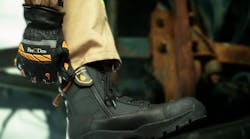Unfortunately, firefighting requires more functional flexibility than most occupations. We have to be able to bend, twist, lift, raise, lower, drag and carry while climbing, walking and in some cases crawling – all the time wearing 60 pounds of gear. These types of movement patterns are much easier if stiff muscles and tendons don’t decrease our range of motion.
Of the five segments of the Fitness Pentagon, flexibility is arguably the most controversial – not because it isn’t important, but because of conflicting research. Studies have shown that too little or too much flexibility may lead to higher risk of musculoskeletal injuries. But there has not been any study that conclusively proves greater flexibility in fact reduces risk. There is also no research that supports a link between low hamstring flexibility and low back pain. However, just because researchers can’t prove causality, doesn’t mean there is no relationship.
Assessment
Lower-back injuries are the leading cause of lost-time injuries in firefighters, so this article will focus on that area. Before assessing lower-back range of motion, you should warm up by walking or jogging for five to 10 minutes. Also, it’s a good idea to warm up before beginning any stretching routine.
After the warm-up, place a 15-inch piece of tape on the floor. Sit on the floor with the bottoms of your feet 12 inches apart and just touching the tape. Keep your knees straight and bend forward at the hips. You should move slowly and smoothly, with your fingertips on top of one another to eliminate cheating by rotating your shoulders.
Have someone measure the distance from your fingertips to the tape. If you can’t reach the tape, your measurement is in negative inches. The table below lists average measurements based on age.
Training
The two basic types of stretching techniques are ballistic (bouncing) stretches and slow-static stretches. While both will promote muscle lengthening, ballistic stretching causes a contraction reaction in the muscle limiting the distance it is allowed to stretch. The muscles react to the ballistic stretch by trying to contract; however, the momentum of the stretch forces the muscle to elongate, causing microscopic tearing of the muscle and connective tissue. Think of the involuntary muscle reaction when you pick up something hot with your bare hand. You immediately drop it and withdraw your hand. When you force your muscles to elongate past their limit, they in turn contract and try to resist the stretch.
Slow-static stretching does not activate the contraction reflex of the muscle. You might say that by slowly sneaking up on the muscle limit, it isn’t aware of the stretch and is more pliable, “going with the flow.” This allows the muscle to elongate without tearing because of added resistance.
We should stretch all of the major muscle groups in the body at least two to three days a week, according to the American College of Sports Medicine (ACSM). Other researchers recommend daily, if possible. Each muscle group should be slowly stretched to a position of mild discomfort and held for 10 to 30 seconds. Three to five repetitions of each stretch are recommended. The following guidelines summarize the stretching exercise prescription:
Core Muscles
Because back injuries are so prevalent and debilitating, it is important to focus on strengthening and stretching the core muscles that support the back. These include all of the lower-back muscles, oblique abdominals and abdominal muscle groups. The series of exercises shown on page 122 can help strengthen the core muscles, limiting the injuries associated with poor muscle strength. These exercises, in addition to more common core exercises like abdominal curls (sit-ups) and push-ups, will develop abdominal and back strength and help you to be ready to work on the fireground. All exercises should be performed in three to five repetitions at least three days per week.
This is by no means a complete stretching routine. There are many good books on stretching in your local bookstore, or you could consult with a personal trainer, preferably one who is certified as an IAFF/IAFC/ACE Peer Fitness Trainer, for more information. Again, follow the guidelines above and see your doctor prior to beginning new exercises.
Joint strength and flexibility is the goal of a comprehensive program. By taking part in this oft neglected area of physical fitness, you may be able to avoid those costly sprains and strains so common among firefighters. A proper stretching program, in conjunction with a good core strength program may help you reduce the risk of injury and lost time at work.
Guidelines for Stretching
- Get a physician’s approval any time you start a new exercise or stretching routine
- Warm up prior to performing any stretching routine
- Concentrate on relaxing the muscle you are stretching
- Hold the stretch for 10 to 30 seconds
- Stretch to a point of mild discomfort. Forget the “no pain, no gain” theory
- Exhale as you stretch, allowing the stress to go out of your body
- Stretch all muscle groups in different planes if the joint allows it
According to the ACSM, contraindications for flexibility and range of motion training include:
- Motion limited by a bony block at a joint interface
- Recent unhealed fracture
- Infection and acute inflammation affecting the joint or surrounding area
- Sharp pain associated with the stretch or uncontrolled muscle cramping
- Local bruising as a result of over-stretching
















